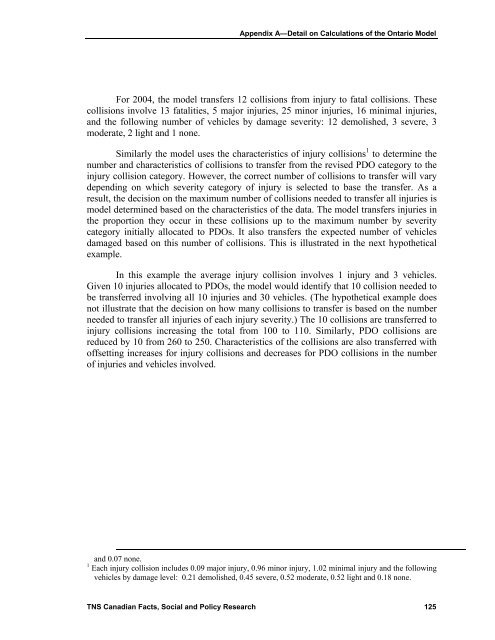Keith Vodden Dr. Douglas Smith - Transports Canada
Keith Vodden Dr. Douglas Smith - Transports Canada
Keith Vodden Dr. Douglas Smith - Transports Canada
You also want an ePaper? Increase the reach of your titles
YUMPU automatically turns print PDFs into web optimized ePapers that Google loves.
Appendix A—Detail on Calculations of the Ontario Model<br />
For 2004, the model transfers 12 collisions from injury to fatal collisions. These<br />
collisions involve 13 fatalities, 5 major injuries, 25 minor injuries, 16 minimal injuries,<br />
and the following number of vehicles by damage severity: 12 demolished, 3 severe, 3<br />
moderate, 2 light and 1 none.<br />
Similarly the model uses the characteristics of injury collisions 1 to determine the<br />
number and characteristics of collisions to transfer from the revised PDO category to the<br />
injury collision category. However, the correct number of collisions to transfer will vary<br />
depending on which severity category of injury is selected to base the transfer. As a<br />
result, the decision on the maximum number of collisions needed to transfer all injuries is<br />
model determined based on the characteristics of the data. The model transfers injuries in<br />
the proportion they occur in these collisions up to the maximum number by severity<br />
category initially allocated to PDOs. It also transfers the expected number of vehicles<br />
damaged based on this number of collisions. This is illustrated in the next hypothetical<br />
example.<br />
In this example the average injury collision involves 1 injury and 3 vehicles.<br />
Given 10 injuries allocated to PDOs, the model would identify that 10 collision needed to<br />
be transferred involving all 10 injuries and 30 vehicles. (The hypothetical example does<br />
not illustrate that the decision on how many collisions to transfer is based on the number<br />
needed to transfer all injuries of each injury severity.) The 10 collisions are transferred to<br />
injury collisions increasing the total from 100 to 110. Similarly, PDO collisions are<br />
reduced by 10 from 260 to 250. Characteristics of the collisions are also transferred with<br />
offsetting increases for injury collisions and decreases for PDO collisions in the number<br />
of injuries and vehicles involved.<br />
and 0.07 none.<br />
1 Each injury collision includes 0.09 major injury, 0.96 minor injury, 1.02 minimal injury and the following<br />
vehicles by damage level: 0.21 demolished, 0.45 severe, 0.52 moderate, 0.52 light and 0.18 none.<br />
TNS Canadian Facts, Social and Policy Research 125
















